Price and Value
The Canon EF-S 18-135mm f/3.5-5.6 IS USM Lens hit the streets with a price tag modestly higher than its STM predecessor’s same-time-current price.
The 18-135 USM is a good lens and this price makes it a decent value.
Where the STM version became a really good value was in a kit with a DSLR camera (we have also posted some excellent deals for this lens).
The 18-135mm USM was introduced simultaneously with the Canon EOS 80D and is available with that camera in a kit.
However, there is (initially) no discount for buying the two together.
Watch for that to change.
Canon’s standard warranty is 1 year.
While this duration is among the shortest in the industry, my Canon gear seldom needs serviced.
And, Canon’s service and customer support is among the best available.
The reviewed 18-135mm USM lens was online retail sourced.
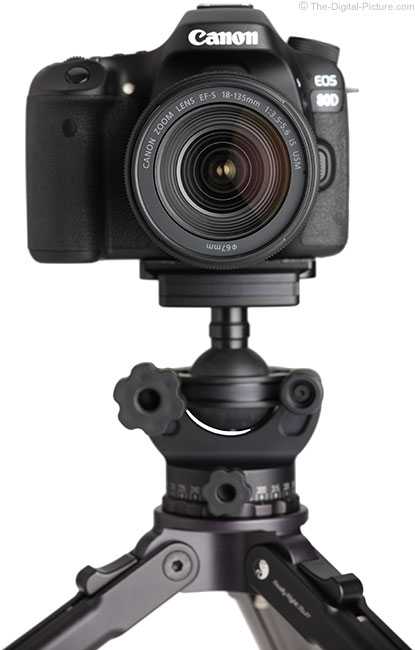
Alternatives to the Canon EF-S 18-135mm IS USM Lens
With the general purpose lens being such a big one, consumers have a lot of choices.
For many, the decision to buy the EF-S 18-135 IS USM will be weighed against the EF-S 18-55mm IS kit lens available at the time.
At review time, that lens is the Canon EF-S 18-55mm f/3.5-5.6 IS STM Lens.
The 18-55 has the low price, small size and light weight advantage, but the 18-135 USM has a much longer focal length range and faster/better AF system.
These two lenses are simiarly sharp until the long end of the 18-55’s range is reached, where the 18-135 has the advantage.
Though I expect the Canon EF-S 18-135mm f/3.5-5.6 IS STM Lens to be phased out of production, this lens
is very similar to the 18-135 USM.
Nano Ring USM is the USM version’s primary advantage and modestly lower price is the STM’s advantage.
For those looking for a long focal length range, the Canon EF-S 18-200mm f/3.5-5.6 IS Lens will be another consideration.
The 200mm long end of that range is very noticeably longer than 135mm.
At 8 years of age, the 18-200 is starting to show signs of age.
This lens was skipped over (as of review time) for the STM AF treatment and the 18-135 now has the next improved AF system, Nano Ring USM, to its strong advantage.
The 18-135 is a sharper lens overall and would usually be my choice over the 18-200.
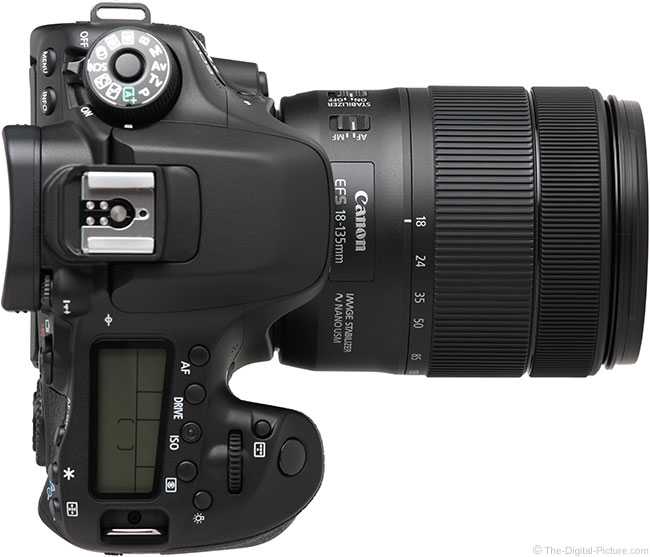
Focal Length / Focal Length Range
Narrowing down the focal length or focal length range ideal for your photographic needs is the first criterion for lens selection.
The focal length chosen for a particular image determines the distance required for proper framing and in turn, the perspective.
There are times when the ideal subject distance cannot be obtained, perhaps due to an obstacle (such as a wall), and in those cases, having a zoom range to work with permits ideal subject framing from the
subject distance available to you.
The focal length range of this lens is a hugely valuable asset.
As an «EF-S» lens, the 18-135 IS USM is only compatible with Canon APS-C format cameras.
permitting APS-C-only «EF-S» lenses to be smaller, lighter and less expensive relative to their full frame lens counterparts (which remain compatible with the APS-C cameras).
With a smaller imaging sensor than full frame models, APS-C format cameras do not require the larger image circle projected by full frame compatible lenses,
permitting APS-C-only «EF-S» lenses to be smaller, lighter and less expensive to manufacture relative to their full frame lens counterparts (which remain compatible with the APS-C cameras).
Using a smaller image circle means that APS-C sensor format cameras frame a scene more tightly, with 1.6x being the multiplier (FOVCF)
used to determine the full frame angle of view equivalent.
Multiplying 18-135mm by 1.6x yields 28.8-216mm, the full frame 35mm format camera angle of view equivalent for this lens.
The list of uses for these focal lengths is as long as the focal length range itself.
Even if I had the time to create a comprehensive list of uses for this wide general purpose focal length range,
you would not likely have the time or interest to read it.
But, I’ll get you started with some ideas.
For sure is that this is an excellent travel lens.
When traveling, especially when not driving yourself to the location, your luggage size and weight is likely limited.
Fewer lenses with smaller size and weights make conforming to these requirements easier.
Also, traveling frequently involves spending lots of time with a camera in hand.
The same reasons make this use less tiring and more pleasant.

A superb set of portrait focal lengths are built into this lens, including the much-acclaimed 85-135mm (full frame angle of view equivalent) range.
The ideal focal lengths are provided for full body portraits (29mm was used for the above image) through tight head shots.
Preserving family memories can be fully accommodated by these focal lengths.
While I prefer a lens that zooms out to a 24mm angle of view equivalent (15mm) if landscape photography is on my to-do list, the 29mm equivalent angle of view (at 18mm) will take in moderately wide views of nature.
And, the rest of the focal lengths included in this lens are all very useful for landscape photography.
The video uses for this focal length range are similar as for still photos.
For an example of what this focal length range looks like, we head below the Ben Franklin Bridge in New Jersey and view the Philadelphia skyline below it.

18mm |
24mm |
35mm |
50mm |
85mm |
135mm
If you are considering a lens with 50mm or similar at the long end, specifically compare the 50mm focal length to 135mm.
The difference is dramatic – the extra length is really nice to have without a lens change required.
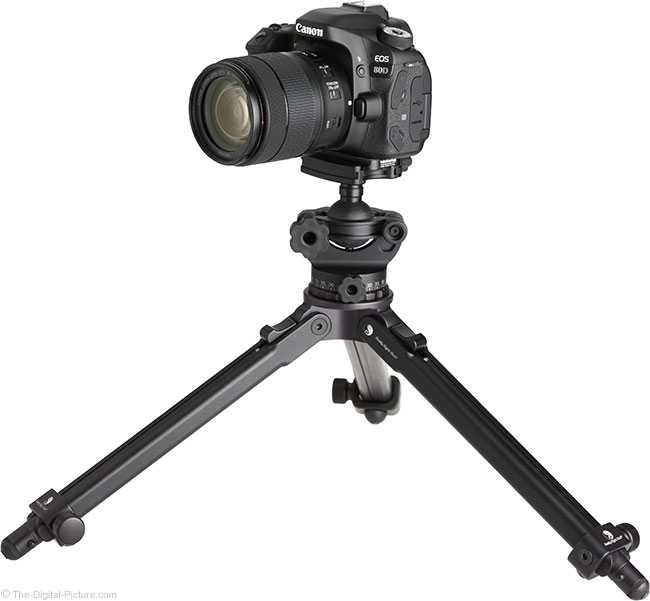
Build Quality & Features
The 18-135 STM was a nicely built, nice-to-use lens and the 18-135 USM has received a bit of a makeover.
Here are the two shown side-by-side.
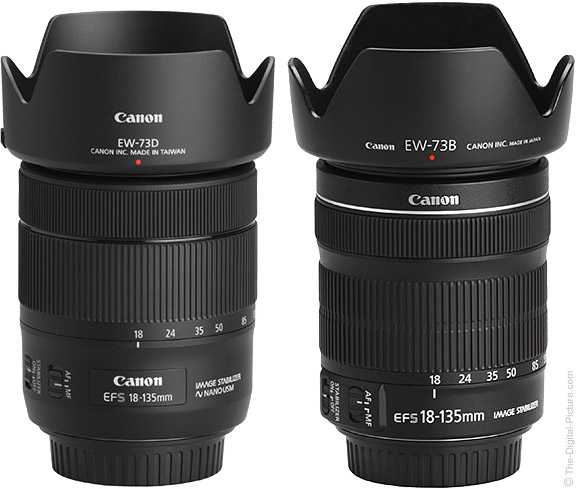
The USM version takes on a modernized appearance and loses the silver ring.
Aided by a completely flush-mount switch bank, the 18-135mm USM maintains a very even profile over much of the lens barrel, making it comfortable to hold and easy to use.
This lens features a simple exterior that is primarily zoom and focus rings.
The zoom ring has been shifted forward in position and reduced slightly in size to 1.28″ from 1.62″ (32.5mm vs. 41.2mm).
The manual focus ring has been increased in size slightly from 0.5″ to 0.79″ (12mm to 20mm) and has also been moved forward slightly.
These rings are ideally positioned, have ideal sizes, are smooth functioning, have no play and have a nice rotational resistance/dampening.
Here is a closer look at the EF-S 18-135mm IS USM lens:
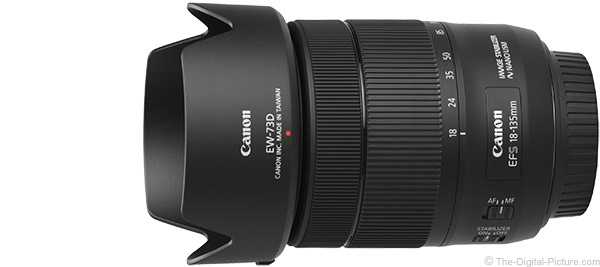
MFD |
∞
MFD |
∞
w/ Hood: MFD |
∞
MFD |
∞
Rotated
Compare »
Like all of the other zoom lenses with a similar focal length range, the 18-135 USM extends with focal length increase (up to 1.95″/49.5mm).
There is no play in the inner/extending lens barrel even at full extension.
A lock switch is provided to retain the lens in fully retracted position (only), preventing gravity zooming.
This was not an issue on the review lens, but the switch is there if auto extension ever becomes present.
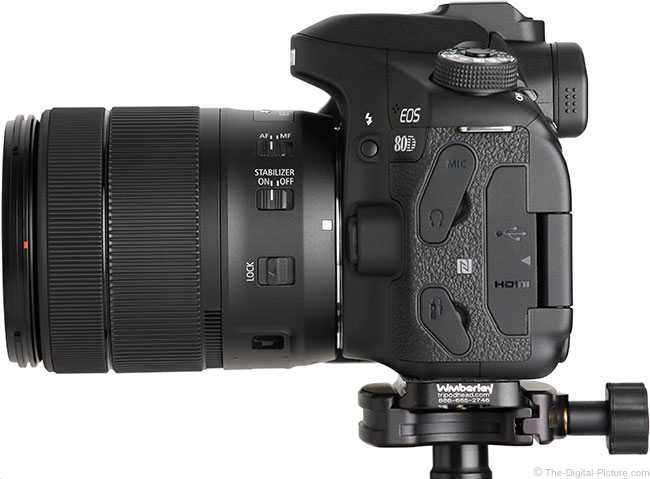
Normal for EF-S lenses is a quality plastic barrel and the 18-135 USM also has this.
The finish is attractive and the usual ribbed-rubber-covered rings give the lens a quality feel.
While this is a nicely built lens, it is not one of Canon’s pro-grade models.
Notably missing is full weather sealing, including a lens mount gasket seal.
Recommended is to keep this lens dry.
Small and light, especially for the focal length range, is a huge benefit of this lens.
Here is a table comparing a variety of lens models:
| Model | Weight | Dimensions w/o Hood | Filter | Year | ||
| Canon EF-S 15-85mm f/3.5-5.6 IS USM Lens | 20.3 oz | (575g) | 3.2 x 3.4″ | (81.6 x 87.5mm) | 72mm | 2009 |
| Canon EF-S 17-55mm f/2.8 IS USM Lens | 22.8 oz | (645g) | 3.3 x 4.4″ | (83.5 x 110.6mm) | 77mm | 2006 |
| Canon EF-S 18-55mm f/3.5-5.6 IS STM Lens | 7.2 oz | (205g) | 2.7 x 3.0″ | (69.0 x 75.2mm) | 58mm | 2013 |
| Canon EF-S 18-135mm f/3.5-5.6 IS USM Lens | 18.2 oz | (515g) | 3.1 x 4.2″ | (77.5 x 105.4mm) | 67mm | 2016 |
| Canon EF-S 18-135mm f/3.5-5.6 IS STM Lens | 16.9 oz | (480g) | 3.0 x 3.8″ | (76.6 x 96.0mm) | 67mm | 2012 |
| Canon EF-S 18-135mm f/3.5-5.6 IS Lens | 16.1 oz | (455g) | 3.0 x 4.0″ | (75.4 x 10.01mm) | 67mm | 2009 |
| Canon EF-S 18-200mm f/3.5-5.6 IS Lens | 21 oz | (595g) | 3.1 x 4.0″ | (78.6 x 10.02mm) | 72mm | 2008 |
| Canon EF 24-70mm f/2.8L II USM Lens | 28.4 oz | (805g) | 3.5 x 4.4″ | (88.5 x 113.0mm) | 82mm | 2012 |
| Canon EF 24-70mm f/4L IS USM Lens | 21.2 oz | (600g) | 3.3 x 3.7″ | (83.4 x 93.0mm) | 77mm | 2012 |
For many more comparisons, review the complete Canon EF-S 18-135mm f/3.5-5.6 IS USM Lens Specifications using the site’s Lens Spec tool.
Seeing the size difference is always nice for those of us who are strongly visually-oriented (photographers in general).
Here is a comparison image featuring a selection of Canon EF-S lenses:
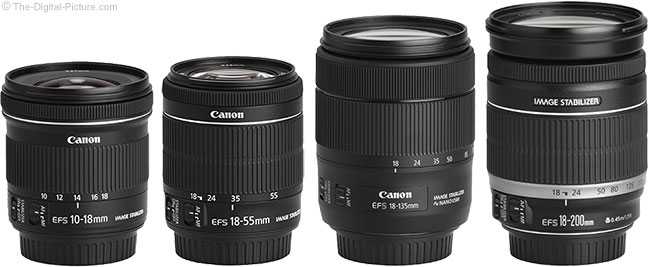
Positioned above from left to right are the following lenses:
Canon EF-S 10-18mm IS STM LensCanon EF-S 18-55mm f/3.5-5.6 IS STM Lens
Canon EF-S 18-135mm f/3.5-5.6 IS USM LensCanon EF-S 18-200mm f/3.5-5.6 IS Lens
The same lenses are shown below, extended with their hoods in place.
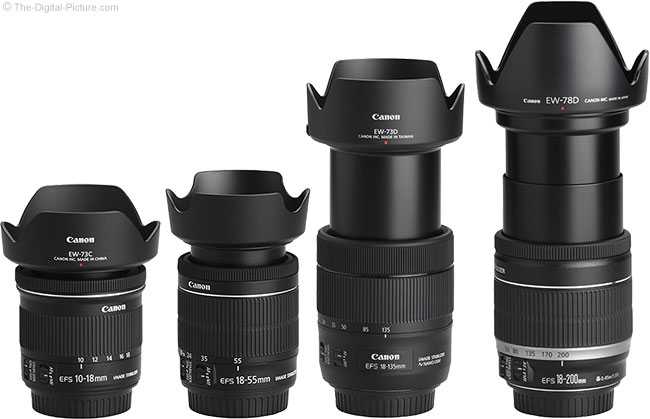
Use the site’s product image comparison tool to visually compare the Canon EF-S 18-135mm IS USM Lens to other lenses.
The 18-135 USM accepts 67mm threaded filters.
These moderate-in-size filters are rather common for Canon lenses and not too pricey.
I recommend using slim model filters such as the B+W XS-Pro line for this lens as standard thickness filters may create some mechanical vignetting at the wide end of the focal length range.
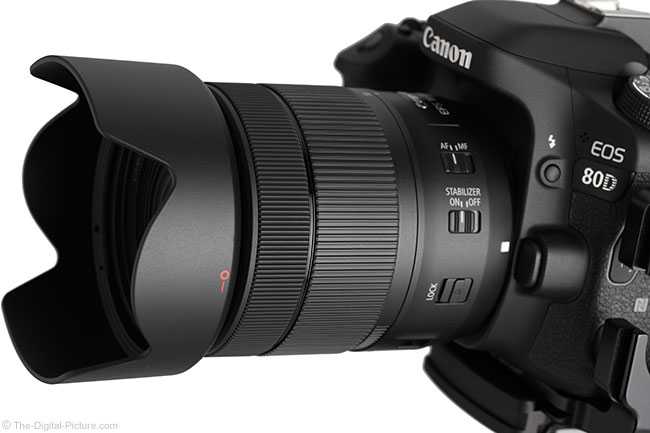
While I nearly always recommend using a lens hood, the price of this matte black plastic (interior and exterior) hood seems high.
Canon should have included this one in the box as the U.S.A. press release hinted.
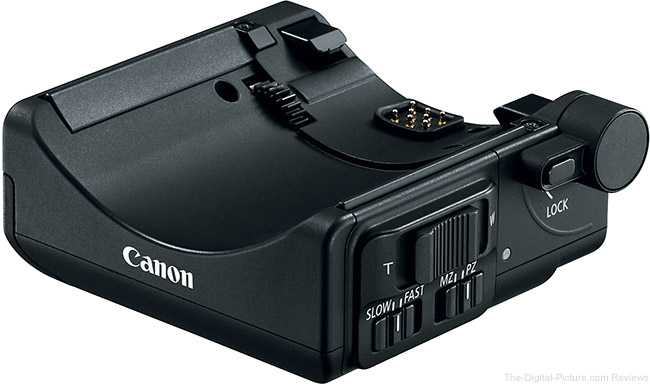
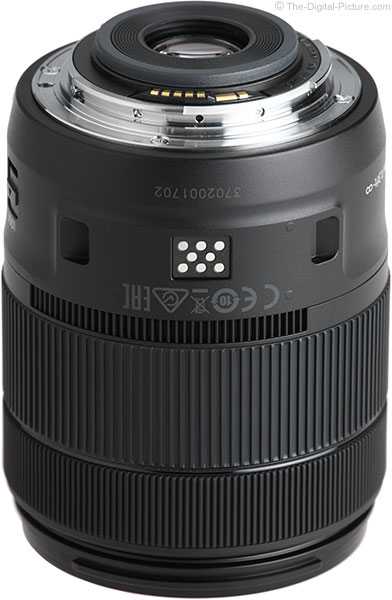
The PZ-E1 attaches to the bottom of the lens (see mount and electronic contacts above) and via a gear that interlocks with the groves in the zoom ring,
providing silent electronic zoom control, including remotely from a Canon app.
The zoom speed is adjustable, ranging from 2.4 sec up to 14 seconds for a full extents zoom change.
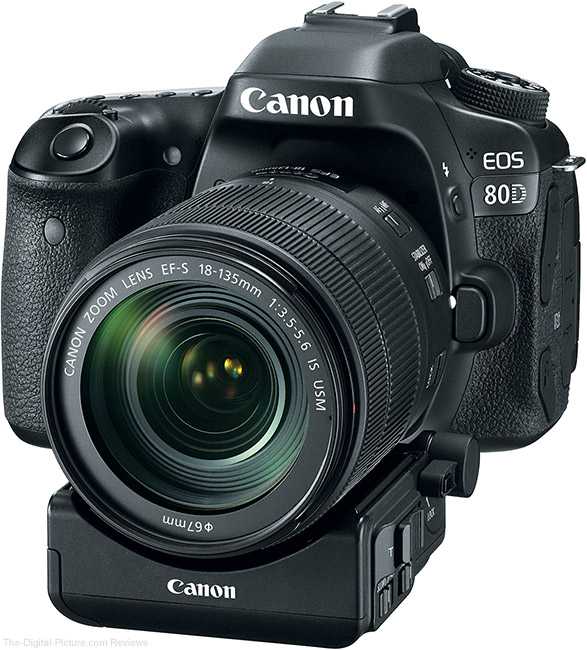
Front |
Angle
Max Aperture
The f/3.5-5.6 in the lens name refers to the lens’ max aperture opening, the relationship of the lens opening (diaphragm) to focal length.
The lower the number, the more light the lens will allow to reach the sensor.
Each «stop» in aperture change (examples: f/2.8, f/4.0, f/5.6, f/8, f/11) increases or reduces the amount of light reaching the sensor by a factor of 2x (a big deal).
Because aperture is measured as a ratio of lens opening to focal length and because this lens has a (basically) constant maximum opening, this lens has a variable max aperture.
As the focal length increases, the maximum opening size does not appreciably increase, resulting in aperture measurements stepping down.
Here is a chart showing the specific focal lengths where this happens along with the same information for a selection of other lenses.
| Model | f/3.5 | f/4.0 | f/4.5 | f/5.0 | f/5.6 |
| Canon EF-S 15-85mm f/3.5-5.6 IS Lens | 15mm | 18mm | 27mm | 38mm | 61mm |
| Canon EF-S 17-85mm f/4-5.6 IS Lens | 17mm | 26mm | 38mm | 47mm | |
| Canon EF-S 18-55mm f/3.5-5.6 IS STM Lens | 18mm | 24mm | 32mm | 37mm | 47mm |
| Canon EF-S 18-135mm f/3.5-5.6 IS USM Lens | 18mm | 24mm | 35mm | 50mm | 76mm |
| Canon EF-S 18-135mm f/3.5-5.6 IS STM Lens | 18mm | 24mm | 35mm | 50mm | 76mm |
| Canon EF-S 18-200mm f/3.5-5.6 IS Lens | 18mm | 24mm | 40mm | 50mm | 90mm |
| Canon EF 24-105mm f/3.5-5.6 IS STM Lens | 24mm | 28mm | 42mm | 50mm | 67mm |
If your lens is missing from this list, head over to the full
Canon EF-S 18-135mm f/3.5-5.6 IS USM Lens specifications with the site’s Lens Spec tool enabling far more comparisons.
While the step-downs occur in 1/3 stop increments, somewhat unusual is the f/5 aperture remains selected when the aperture is changed by one click at 50mm.
Canon’s software calls the actual aperture f/5.0 for both clicks, but Adobe Bridge indicates that the «Max Aperture Value» (max available) is f/4.8.
This is only a very minor concern, but I encountered it frequently when testing at 50mm.
Allowing more light to reach the sensor permits freezing action and handholding the camera in lower light levels and can also permit use of lower (less noisy) ISO settings.
In addition to allowing more light to reach the sensor, increasing the opening permits a stronger, subject-isolating background blur (at equivalent focal lengths).
Lenses with an opening to at least a specific aperture (usually f/2.8) enable the higher precision AF capabilities (most often the center AF point) in some cameras and present a brighter viewfinder image.
Another benefit, especially when shooting in Manual exposure mode, is that constant max aperture lenses permit that max aperture to be set and remain constant regardless of the focal length selected.
The advantages to a narrow aperture, because the size of the lens elements can be reduced significantly in size, include smaller size, lighter weight and lower cost.
Those are three things that we all can appreciate.
Relative to the max aperture available in other lenses, the Canon EF-S 18-135mm f/3.5-5.6 IS USM Lens is relatively «slow», with few other lenses having narrower max apertures.
However, many are near-equivalents and this max aperture range is not unusual, especially for non-professional lenses.
Still, this would not be my first choice lens for indoor sports and similar.
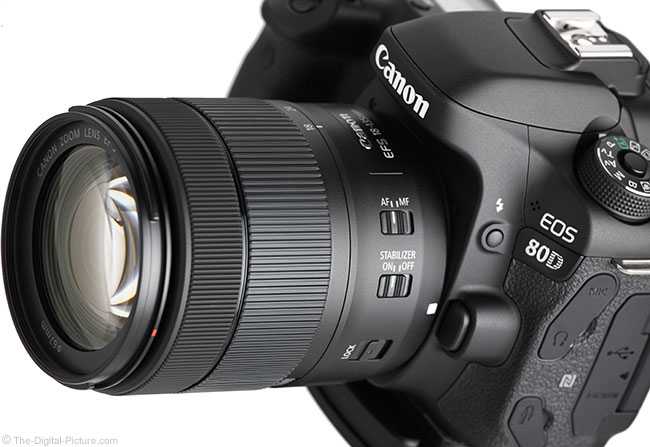
Reasons to Buy Canon EF-S 18-135mm f3.5-5.6 IS STM Lens
Here we’ve included a summary of the advantages and disadvantages of the Canon EF-S 18-135mm f3.5-5.6 IS STM lens in a list form to help you determine whether it offers the features you need.
PROs
| Optical Image Stabilization |
| Autofocus |
| Full-time Manual Focusing |
| Internal Focusing |
| Zoom Lock |
| Versatile Lens with a Zoom Ratio of 7x |
Report a correction
Buy Canon 18-135mm f3.5-5.6 IS STM from or B&H PHOTO
CONs
| No Weather Sealing |
| Hood is not supplied |
| Slow Aperture at Tele end |
| Variable Aperture |
Lens Mount
Canon 18-135mm f3.5-5.6 IS STM is compatible with cameras that have a Canon EF-S lens mount. Some of the latest released cameras that are compatible with the Canon EF-S lenses are Canon T8i, Canon 90D and Canon SL3.
Size, Weight and Filter Thread
Size and weight is a very important decision factor when searching for your next lens. Canon 18-135mm f3.5-5.6 IS STM has a maximum diameter of 77mm and total length of 96mm. It weighs 480g / 16.9 oz.
Canon 18-135mm f3.5-5.6 IS STM has a filter thread of 67mm. Below are links to the filters that we recommend you to consider for your Canon 18-135mm f3.5-5.6 IS STM:
Optical Image Stabilization
The Canon 18-135mm f3.5-5.6 IS STM features an optical image stabilization system which helps to reduce the blur that occurs due to shaking during hand-held shooting.
Zoom Method
Canon 18-135mm f3.5-5.6 IS STM features Rotary (internal) zoom method where the length of the lens doesn’t change while you are zooming in or out. Even though this design has a size disadvantage in general compared to extending designs, it has the benefits of better sealing against dust and moisture, no zoom creep and no weight balance shift while zooming.
Zoom Lock
Canon 18-135mm f3.5-5.6 IS STM has a Zoom lock feature which eliminates Zoom creep where focal length of the lens changes with gravity when it’s held downwards or upwards.
Maximum Magnification Ratio
Canon 18-135mm f3.5-5.6 IS STM has a Max Magnification Ratio of 0.28x and has a minimum focusing distance of 0.39m. For a non-macro lens, the 0.28x is considered a high magnification and will come handy for close-up shots.
Below are the 3 Superzoom Zoom type Canon1 mount lens alternatives with highest max magnification ratios:
- Sigma 18-200mm F3.5-6.3 DC OS HSM C: 0.33x — (Compare)
- Canon 28-300mm f3.5-5.6L IS USM: 0.3x — (Compare)
- Tamron 28-300mm f3.5-6.3 VC PZD: 0.29x — (Compare)
Aperture
Canon 18-135mm f3.5-5.6 IS STM is a variable aperture lens with a max aperture of f3.5 and a minimum aperture of f22 at 18mm, and a max aperture of f5.6 and minimum aperture of f38 at 135mm .
| Focal Length | Max Aperture | Min Aperture |
|---|---|---|
| 18mm | F3.5 | F22 |
| 135mm | F5.6 | F38 |
Optical Formula
Canon 18-135mm f3.5-5.6 IS STM’s optical formula consists of 16 elements in 12 groups . Special elements used in this design is Super Spectra coatings.
Lens Hood
Canon 18-135mm f3.5-5.6 IS STM doesn’t come with a lens hood. You have to order the hood separately and the model number of the hood is EW-73B.
Popular Comparisons of Canon 18-135mm f3.5-5.6 IS STM
Top Alternatives of Canon 18-135mm f3.5-5.6 IS STM Lens
| Model | Coverage | Weight | Focusing | Street Price | |
|---|---|---|---|---|---|
|
Canon EF-S 18-135mm F3.5-5.6 IS USM Compare |
APS-C / DX | 515 g / 1.13 lb | AF | ||
|
Canon EF 50mm f1.8 STM Compare |
35mm FF | 159 g / 0.35 lb | AF | ||
|
Canon EF-S 18-200mm f3.5-5.6 IS Compare |
APS-C / DX | 595 g / 1.31 lb | AF | ||
|
Sigma 18-125mm F3.8-5.6 DC OS HSM Compare |
APS-C / DX | 490 g / 1.08 lb | AF | ||
|
Canon EF-S 55-250mm f4-5.6 IS STM Compare |
APS-C / DX | 375 g / 0.83 lb | AF | ||
|
Canon EF-S 15-85mm f3.5-5.6 IS USM Compare |
APS-C / DX | 575 g / 1.27 lb | AF | ||
|
Canon EF 75-300mm f4.0-5.6 IS USM Compare |
35mm FF | 650 g / 1.43 lb | AF | ||
|
Canon EF-M 15-45mm F3.5-6.3 IS STM Compare |
APS-C / DX | 130 g / 0.29 lb | AF |
Image Stabilization
While this lens does not have the widest apertures available, image stabilization aids in handholding the camera in lower light levels and enables lower ISO settings to be used.
When IS is in use, longer handheld exposures can be used without camera motion blur showing in the image.
Stabilizing the image does nothing to slow a subject in motion, so IS does not aid in freezing subject movement in a picture.
When the shutter is half-pressed, Live View is started or Video Mode is entered, the EF-S 18-135 USM’s IS system goes into action.
Fortunately, the only hint to IS being active is the image becoming very noticeably more still, making ideal subject framing easier.
This is one of the quietest IS systems available.
It is practically silent with only very light clicking and humming heard with an ear immediately next to lens.
Unlike some stabilization implementations, the image does not bounce in the viewfinder even on startup and shutdown, and the image remains stable even with the camera being moved around (important for video recording).
If the camera is held very still (nearly tripod-steady such as when braced against something stationary), some framing drift can be seen.
That is reason alone to turn IS off when shooting from a tripod.
Canon rates this IS implementation for 4 stops of assistance, meaning the lens can be handheld in 16x lower light levels than without IS.
Your results will vary greatly depending on a variety of factors affecting your ability to hold the camera steady during the exposure, including wind, footing stability, state of relaxation, skill, etc.
Also, your tolerance for keeper rate percentage comes into play.
If you don’t mind taking 20 photos to insure that one sharp image is captured, you can use this lens under lower light levels than someone who requires every frame to be sharp.
Under controlled (favorable) test conditions, I could handhold the EF-S 18-135 USM lens at 18mm with a high keeper percentage at 1/4 second shutter speeds, representing about 3 stops of assistance for me.
At 1/4 second I hit a wall on this day, with a very low keeper rate at longer exposures.
At 135mm, I had a near perfect set at 1/15 of a second, representing just under 4 stops of assistance for me.
At this focal length, the keeper rate slowly declined as exposure times increased with sharp images captured even at 1/5 second.
I find image stabilization to be a great feature on any lens, but I find it especially useful on a narrow aperture lens such as this one.
Due to low inertia, light lenses can sometimes be harder to hold steady than heavier ones, making IS even more important on this lens.
The 18-135 USM’s image stabilization system provides a very steady viewfinder image and definitely increases my keeper rate.
I should note that a tripod can provide the same benefit, though with added inconvenience and reduced flexibility.
Impatient subjects may not appreciate the tripod option.
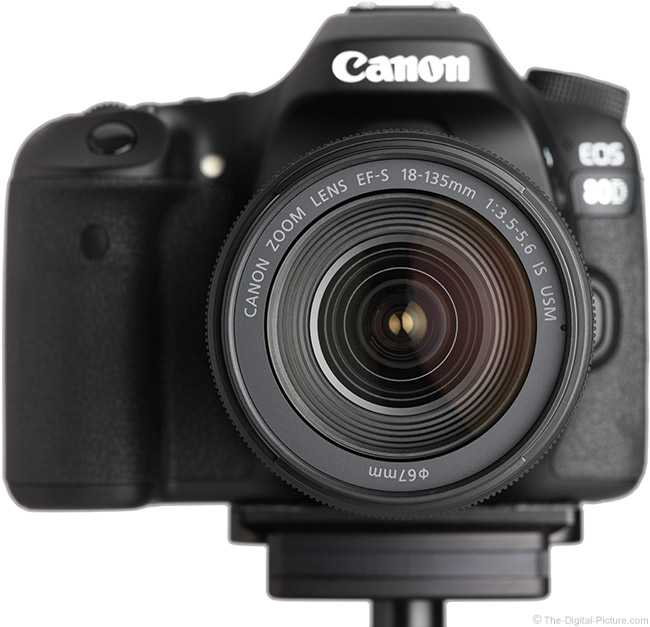
Summary
While my kit is comprised of mostly pro-grade lenses, I have an 18-135mm STM lens in it and will mount that lens on occasion.
That the USM version is a significant upgrade from an auto focus system perspective, it represents an even more valuable member in a kit.
This is a small, light and reasonably-priced lens with effective image stabilization and a great general purpose focal length range.
Combining the best aspects of USM and STM focusing technology, this lens represents an equally compelling option for both still photo and video needs.
Bringing you this site is my full-time job (typically 60-80 hours per week). Thus, I depend solely on the commissions received from you using the links on this site to make any purchase. I am grateful for your support! — Bryan
My Recommended Canon EF-S 18-135mm f/3.5-5.6 IS USM Lens Retailers
Rent the Canon EF-S 18-135mm f/3.5-5.6 IS USM Lens
The Tip Jar
More Canon EF-S 18-135mm f/3.5-5.6 IS USM Lens Related Information
Canon EF-S 18-135mm f/3.5-5.6 IS USM Lens
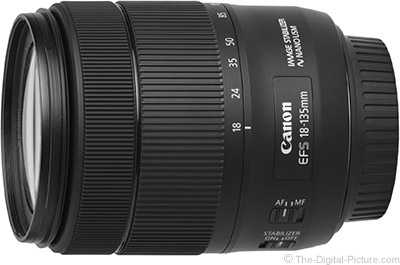
- Specifications
- Press Release
by Bryan Carnathan
Manufacturer ID:1276C002Review Date: 2016-04-11
Navigate the Reviews« Canon EF-S 18-55mm f/4-5.6 IS STM Lens Review» Canon EF 24-70mm f/2.8L II USM Lens Review
Canon & Sony News, Deals, Blog
- Bull Elk Hiding in a Pine Tree, Rocky Mountain National Park
… More Canon & Sony News
























